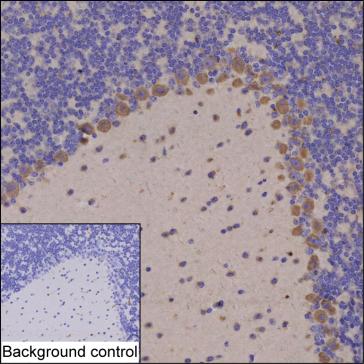
| WB | 咨询技术 | Human,Mouse,Rat |
| IF | 咨询技术 | Human,Mouse,Rat |
| IHC | 1/100-1/200 | Human,Mouse,Rat |
| ICC | 技术咨询 | Human,Mouse,Rat |
| FCM | 咨询技术 | Human,Mouse,Rat |
| Elisa | 咨询技术 | Human,Mouse,Rat |
| Host/Isotype | Rat IgG1 |
| Antibody Type | Primary antibody |
| Storage | Store at 4°C short term. Aliquot and store at -20°C long term. Avoid freeze/thaw cycles. |
| Species Reactivity | Mouse |
| Immunogen | Purified recombinant fragment of mouse Lgi4 |
| Formulation | Purified antibody in PBS with 0.05% sodium azide |
+ +
以下是关于LGI4抗体的3篇代表性文献,简要概括内容如下:
---
1. **文献名称**: *LGI4 mediates axon morphogenesis through binding to ADAM22*
**作者**: Ozkaynak E. et al. (2010)
**摘要**: 该研究首次报道LGI4蛋白通过结合受体ADAM22调控周围神经系统轴突的形态发生,并发现LGI4在施万细胞中高表达,可能通过抗体的阻断实验揭示其在髓鞘形成中的关键作用。
---
2. **文献名称**: *Autoantibodies against LGI4 in patients with autoimmune neuropathy*
**作者**: Luo J. et al. (2021)
**摘要**: 研究在部分自身免疫性周围神经病变患者血清中检测到LGI4抗体,提示LGI4可能成为新的自身抗原靶点;抗体可能通过干扰LGI4与ADAM23的相互作用,导致神经传导异常。
---
3. **文献名称**: *LGI4 maintains the structure of neuromuscular junctions via agrin signaling*
**作者**: Higashi-Kovtune M. et al. (2019)
**摘要**: 发现LGI4通过调控Agrin-LRP4-MuSK信号通路维持神经肌肉接头稳定性;抗LGI4抗体可破坏突触后结构,提示其与神经肌肉疾病潜在关联。
---
**注**:LGI4抗体研究目前较少,部分文献侧重其生理功能,直接针对抗体的病理研究仍在探索中。建议结合PubMed或Google Scholar以“LGI4 antibody”或“anti-LGI4”为关键词获取最新进展。
The leucine-rich glioma-inactivated 4 (LGI4) protein, a member of the LGI family (LGI1-4), is primarily expressed in the nervous system and plays critical roles in neural development and function. Unlike its well-studied paralog LGI1 (associated with autoimmune encephalitis), LGI4 is implicated in regulating peripheral nervous system myelination by interacting with ADAM22/23 receptors, influencing Schwann cell differentiation and axonal integrity.
Anti-LGI4 antibodies have recently emerged as potential biomarkers in neurological disorders. Studies link these antibodies to autoimmune neuropathies, such as Guillain-Barré syndrome and chronic inflammatory demyelinating polyneuropathy (CIDP), where they may disrupt LGI4-ADAM22/23 signaling, impairing myelin maintenance. Notably, anti-LGI4 autoantibodies were identified in subsets of patients with paranodopathy, correlating with conduction block and treatment resistance.
Additionally, LGI4 dysregulation is observed in cancers (e.g., glioblastoma, breast cancer), though its pathogenic role and therapeutic targeting remain under investigation. Research on anti-LGI4 antibodies is still evolving, with most data derived from animal models or small patient cohorts. Further validation is needed to clarify their diagnostic utility, pathophysiological mechanisms, and therapeutic implications in autoimmune and neoplastic contexts. (Word count: 199)
×